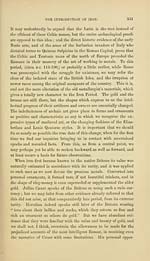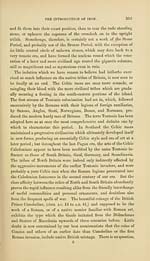Download files
Complete book:
Individual page:
Thumbnail gallery: Grid view | List view

S'yl THE TEUTONIC OU IRuN PEKIOD.
tunities of observation could extend only to a very limited section of
the native Britons, and these seen under the most disadvantageous
circumstances ; while the polished and haughty Roman was little
likely to trouble himself with attempting any very impartial estimate
of what were in his eyes only different phases of barbarism.
The fact has already been adverted to, that all the descriptions of
the weapons of the Gauls furnished by classic writers, lead us to the
conclusion that the ancient bronze leaf-shaped sword had been en-
tirely superseded by the more effective iron weapon prior to their
collision with the veteran legions of Rome. The same is no less true
of the contemporary Britons. Tacitus describes the Caledonians as
" a strong, warlike nation, using large swords without a point, and
targets, wherewith they artfully defended themselves against the
Roman missiles." We know, moreover, that before the Romans
effected a landing in Britain, they were familiar with the fact of an
intimate intercourse having been long maintained with Gaul. The
former is described by Julius Ca?sar as the chief seat of a religion
common to both ; and the evidence is no less explicit which shews
that many of the southern British tribes were of the same race, and
differed little in arts or customs from the Gauls of the neighbouring
continent. But still more, the reason assigned by Caesar for the first
invasion of Britain was the provocation its natives had given him by
the aid which they furnished to his enemies in Gaul. There could
not tiierefore exist any great disparity in their arts or military ac-
coutrements ; while we discover in this no slight evidence of the
maritime skill to which they must have attained even at that early
period, to enable them to embark such bodies of auxiliaries for the
help of the continental tribes as attracted the notice and excited the
indignation of the Roman general.
To the early part of this Age of Iron should most probably be as-
signed the construction of the vast monolithic temple of Stonehenge.
Its difference from the older temples of Avebury and Stennis, as well
as from all other British monuments of this class, has already been
referred to. Rude and amorphous as its vast monoliths are, they are
characterized by such a degree of regularity and uniformity of design,
as marks them to belong to a different era from the Avebury or the
Stennis circle, when the temple-builders had acquired the mastery
of tools with which to hew them into shape. Much greater mechani-
cal skill, moreoA'er, was required to raise the superincumbent masses
tunities of observation could extend only to a very limited section of
the native Britons, and these seen under the most disadvantageous
circumstances ; while the polished and haughty Roman was little
likely to trouble himself with attempting any very impartial estimate
of what were in his eyes only different phases of barbarism.
The fact has already been adverted to, that all the descriptions of
the weapons of the Gauls furnished by classic writers, lead us to the
conclusion that the ancient bronze leaf-shaped sword had been en-
tirely superseded by the more effective iron weapon prior to their
collision with the veteran legions of Rome. The same is no less true
of the contemporary Britons. Tacitus describes the Caledonians as
" a strong, warlike nation, using large swords without a point, and
targets, wherewith they artfully defended themselves against the
Roman missiles." We know, moreover, that before the Romans
effected a landing in Britain, they were familiar with the fact of an
intimate intercourse having been long maintained with Gaul. The
former is described by Julius Ca?sar as the chief seat of a religion
common to both ; and the evidence is no less explicit which shews
that many of the southern British tribes were of the same race, and
differed little in arts or customs from the Gauls of the neighbouring
continent. But still more, the reason assigned by Caesar for the first
invasion of Britain was the provocation its natives had given him by
the aid which they furnished to his enemies in Gaul. There could
not tiierefore exist any great disparity in their arts or military ac-
coutrements ; while we discover in this no slight evidence of the
maritime skill to which they must have attained even at that early
period, to enable them to embark such bodies of auxiliaries for the
help of the continental tribes as attracted the notice and excited the
indignation of the Roman general.
To the early part of this Age of Iron should most probably be as-
signed the construction of the vast monolithic temple of Stonehenge.
Its difference from the older temples of Avebury and Stennis, as well
as from all other British monuments of this class, has already been
referred to. Rude and amorphous as its vast monoliths are, they are
characterized by such a degree of regularity and uniformity of design,
as marks them to belong to a different era from the Avebury or the
Stennis circle, when the temple-builders had acquired the mastery
of tools with which to hew them into shape. Much greater mechani-
cal skill, moreoA'er, was required to raise the superincumbent masses
Set display mode to: Large image | Transcription
Images and transcriptions on this page, including medium image downloads, may be used under the Creative Commons Attribution 4.0 International Licence unless otherwise stated. ![]()
| Early Gaelic Book Collections > J. F. Campbell Collection > Archaeology and prehistoric annals of Scotland > (394) |
|---|
| Permanent URL | https://digital.nls.uk/78376022 |
|---|
| Description | Volumes from a collection of 610 books rich in Highland folklore, Ossianic literature and other Celtic subjects. Many of the books annotated by John Francis Campbell of Islay, who assembled the collection. |
|---|
| Description | Selected items from five 'Special and Named Printed Collections'. Includes books in Gaelic and other Celtic languages, works about the Gaels, their languages, literature, culture and history. |
|---|

